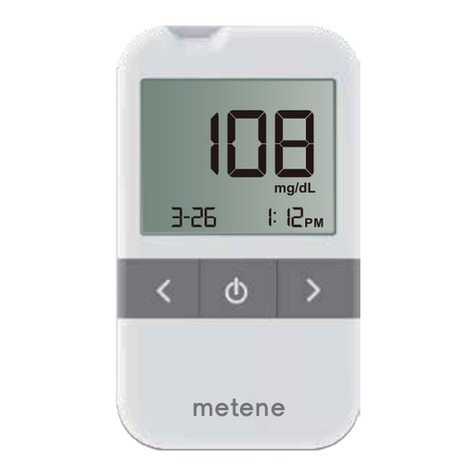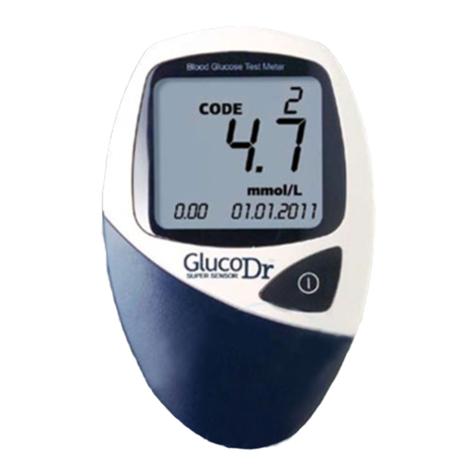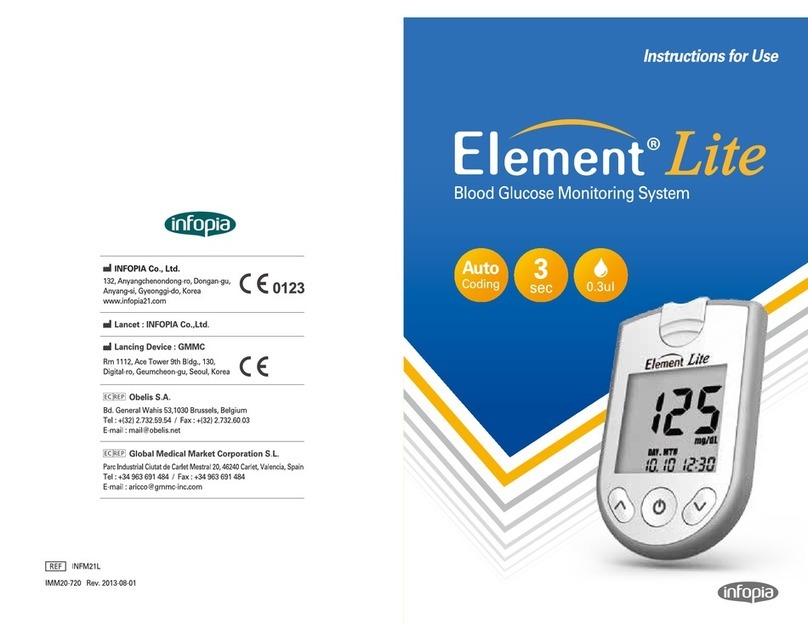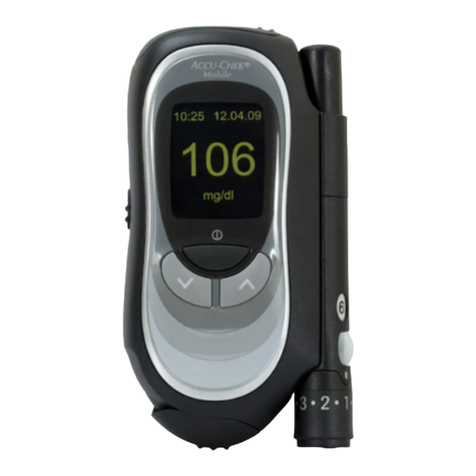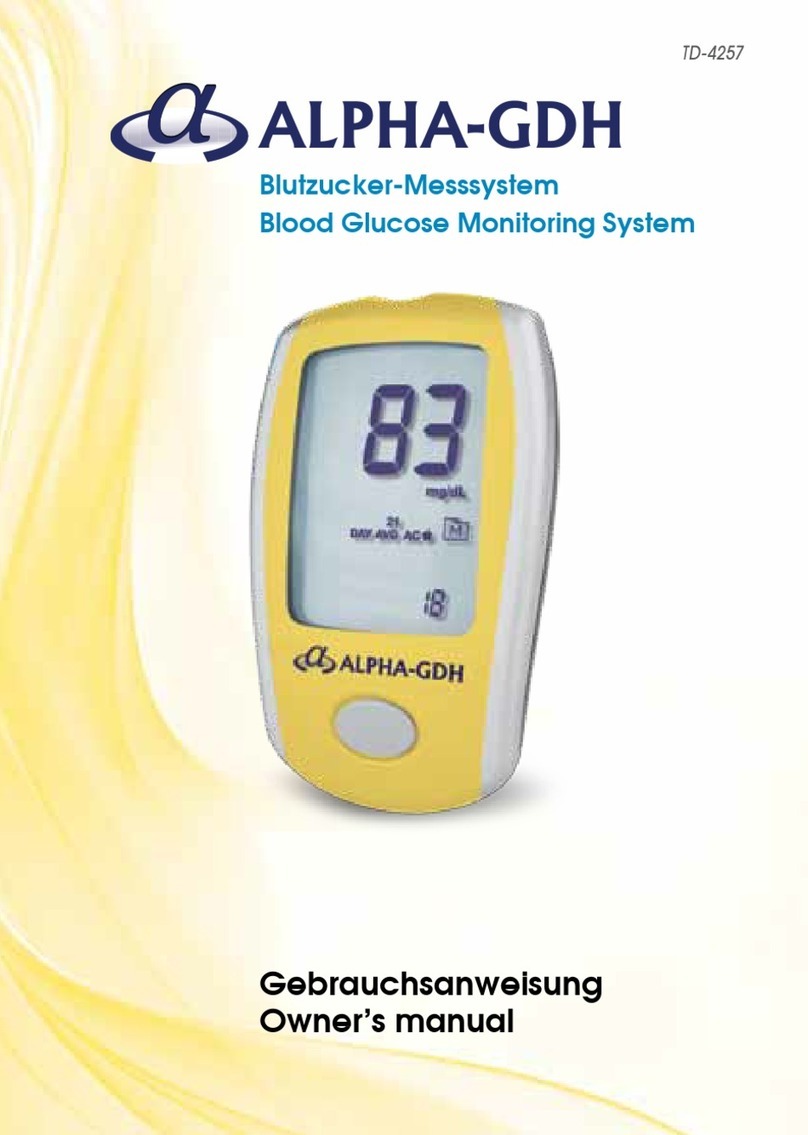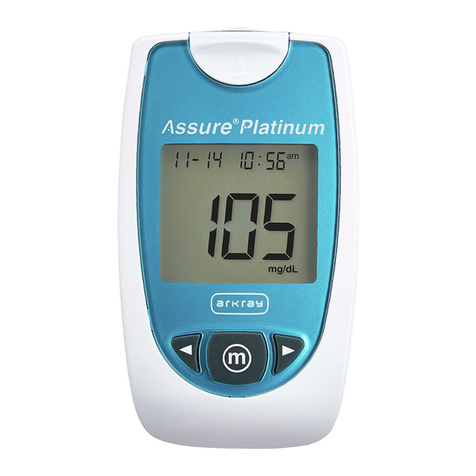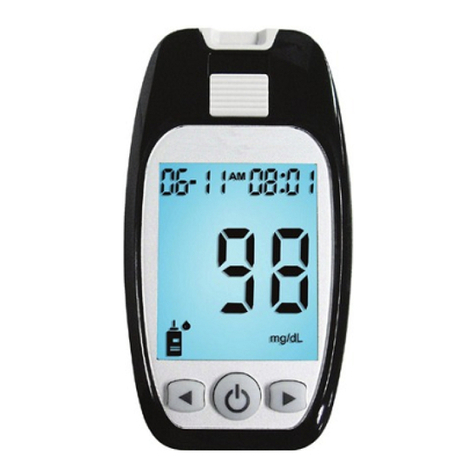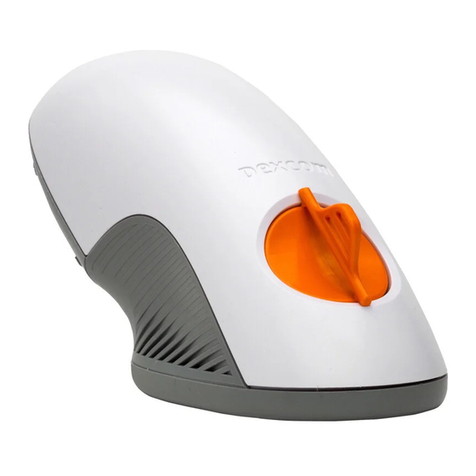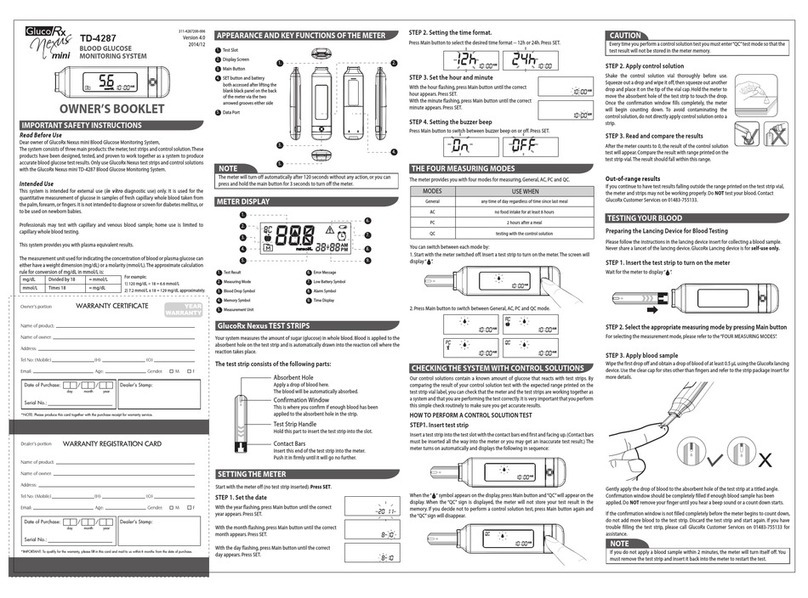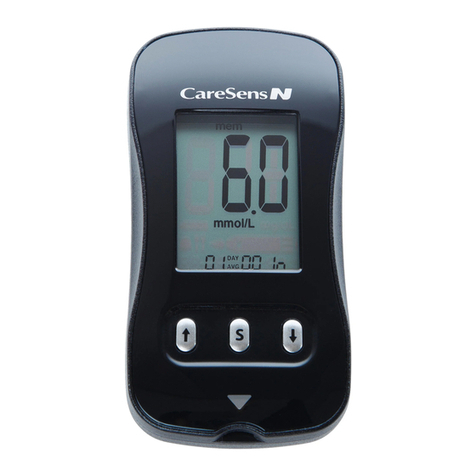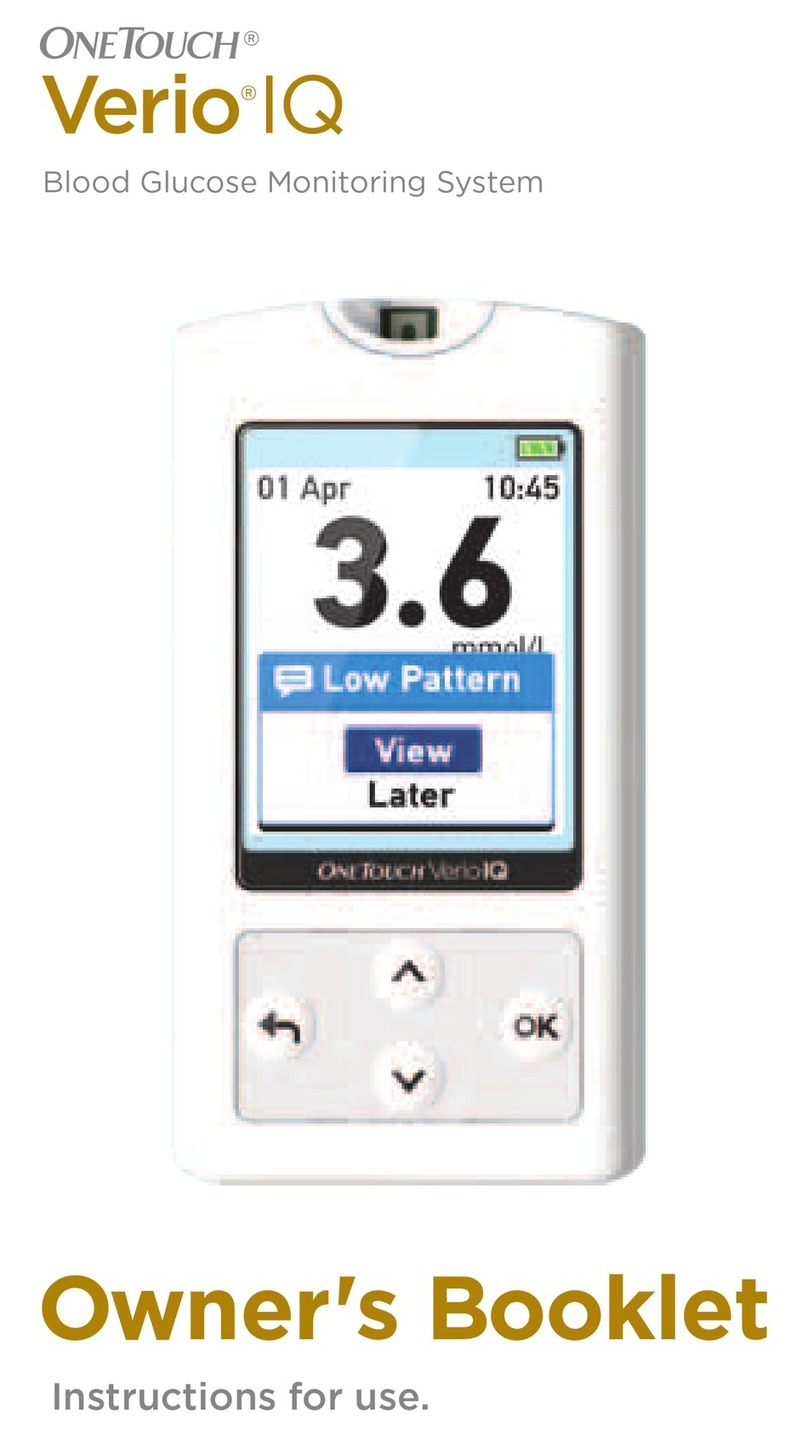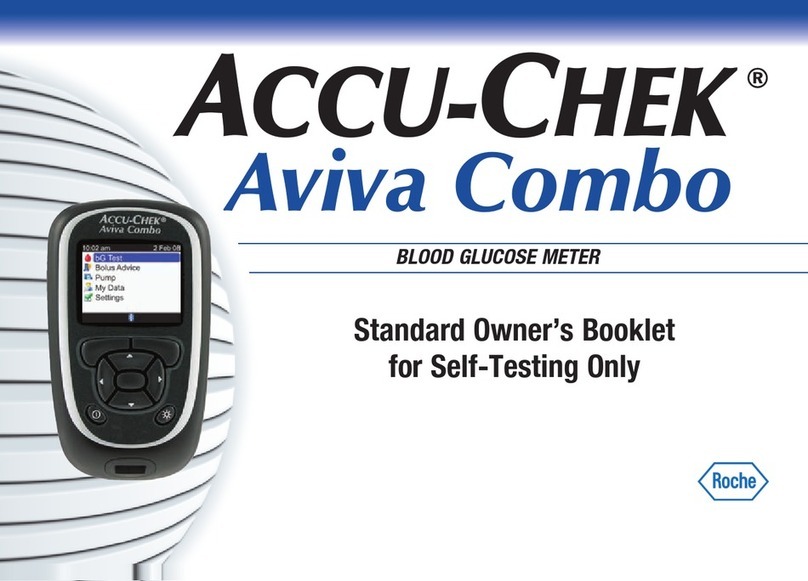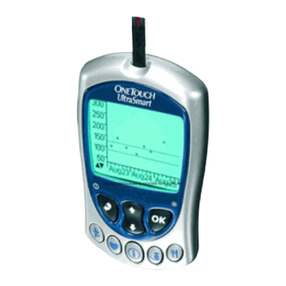All Medicus GlucoDr AGM-2100 User manual

AGM-2100
BLOOD
GLUCOSE
MONITORING
SYSTEM
A112DA302
04/2016
User Manual
Blood Glucose Monitoring System
#7102~7107, #7402, #7403, #7406, 140,
Beolmal-ro, Dongan-gu, Anyang-si,
Gyeonggi-do 431-804 REPUBLIC OF KOREA
www.allmedicus.com
Manufactured by
All Medicus Co., Ltd.
EU Representative
MT Promedt Consulting GmbH
Altenhofstr. 80, D-66386 St. Ingbert, Germany
Tel.: +49 6894 - 58 10 20

08
This summary is intended only as a
quick reference and is not a substitute
for GlucoDr Blood Glucose Monitoring
System User Manual. Please read the
entire this User Manual before you
begin testing
TEST SUMMARY
Turn on the Meter.
Press the power button to
turn on the meter.
Insert a test strip.
Check the code number.
The code number displayed
on the meter must match
the one on the test strip vial.
Apply the blood drop
to the side edge of the
yellow window of the
test strip.
Wait for the blood
drop to completely ll
the yellow window of
the test strip, then the
meter will begin the
countdown.
The blood glucose
result will be
displayed on the
meter in just
11 seconds.

This User Manual will tell you all you need to know
about the system and how it works.
Please read this carefully before using the meter.
“Thank you for using
Blood Glucose Monitoring System”

Test Principle
The blood sample is drawn into the test strip's reaction chamber through capillary action. Glucose in the
sample reacts with glucose oxidase and mediator in the test strip. This reaction creates electrical currents.
The electrical currents produced are proportional to the glucose concentration in the blood and converted
to the equivalent glucose concentration values calculated based on the algorithm programmed in
GlucoDr Meter.
- The GlucoDr Meter is designed for use with GlucoDr Test Strips
(manufactured by All Medicus Co., Ltd.) only.
- The GlucoDr Blood Glucose Monitoring System is calibrated to produce values equivalent to results on
plasma specimens obtained from a laboratory analyzer (YSI 2300 STAT Plus).
- The GlucoDr Blood Glucose Monitoring System should not be used for the diagnosis of diabetes.
- Rapid change in temperature may cause inaccurate test results in reading. When taking the meter from
cold to warm area or from warm to cold area, let the meter sit for about 30 minutes to adjust to the
room temperature.
- Do not drop the meter.
- Do not disassemble, repair or remodel without consultation. The sensitive parts could be damaged and
the warranty will then become invalid.
- A hematocrit that is either very high (above 55%) or very low (below 30%) can cause false test results.
Precautions for Use
For Self-testing: GlucoDr Blood Glucose Monitoring System is for quantitative blood glucose testing in
fresh capillary whole blood. The GlucoDr Blood Glucose Monitoring System is for testing outside the body
(in vitro diagnostic use). The GlucoDr Blood Glucose Monitoring System is intended for use by diabetic lay
users for self testing to improve management of their blood glucose level. The GlucoDr Blood Glucose
Monitoring System should not be used for the diagnosis of or screening of diabetes mellitus, or for
neonatal use.
Intended Use
PRECAUTIONS

Precautions for Test Strip
- Store test strip vials in dry place with temperature ranging between 1~30℃(34~86℉).
- Avoid direct sunlight, heat and excessive humidity.
-
Always close the vial cap immediately after removing a test strip from the vial. If the test strip vial is left
open for a long time, the test strips will become unusable.
- Use the test strip immediately after removing it from the vial.
- Use all the test strips within 4 months after the rst opening.
- Store your test strips only in their original vial and do not transfer them to a new bottle or any other
container.
- Do not handle the test strip with wet hands.
- Do not use the test strip after the expiration date printed on the vial.
- Do not bend, cut, or alter the test strips.
- Do not insert the same test strip into the test port multiple times. It can lead to an improper operation.
Safekeeping
- Store the GlucoDr Meter at a temperature between 15~35℃(59~95℉).
- Store the GlucoDr Meter at a place where relative humidity is less than 85%.
- Keep the GlucoDr Meter in sanitary environment.
- Keep the meter away from direct sunlight.
- Keep the test port away from dirt, blood or water.
- Do not store your meter and test strips in the car, the bathroom, or the refrigerator.
(sensitive to temperature and humidity)
- Keep the meter, test strip vials and lancing materials away from children.
- Clean the outside of the meter using a moist (not wet) cloth or tissue with isopropyl alcohol or mild
detergent with water. Do not immerse the meter in water or other liquid.

·
Getting Started
l 16
l 23
Installing Battery l 24
Display Message Guide l 26
Troubleshooting Guide l 29
Performance Characteristics l 31
Explanation of Symbols l 32
·
Before Testing
·
Performing the Blood Glucose Test with GlucoDr
TM
·
Using the Meter Memory Function
·
Setting the Meter
·
Caring for GlucoDrTM Meter
·
Additional Information
Table of Contents
Understanding Your Test Results l 20
Recalling the Previous Test Results l 21
Checking the Code Number l 06
Checking Your System with GlucoDrTM Control Solution l 09
Preparing the Lancing Device l 13
GlucoDrTM Blood Glucose Monitoring System l 01
GlucoDrTM Meter l 02
GlucoDrTM Meter LCD Display l 04
GlucoDrTM Test Strip l 05
30

GlucoDrTM Blood Glucose Monitoring System
7
“Upon request of distributor, actual package may consist of all
or part of items described above.”
Carrying case
User Manual
GlucoDrTM Meter
GlucoDrTM Test Strips
Batteries
Lancing Device
Lancets

GlucoDrTM Meter
- Test results, icons, symbols and simple messages appear here.
LCD Display
Code Button
Memory Button
- Recall the stored test results in the MEMORY MODE or
change the code number in the CODE MODE.
- Enters into the CODE MODE while pressing the code button.
Power Button
- Turn the meter on/o.

Battery Cover
Test Port
- Insert the GlucoDr Test Strip for testing.
Then the meter turns on and displays the
code number automatically.

GlucoDrTM Meter LCD Display
MEMORY MODE.
CODE MODE .
Battery life.
STRIP ICON.
When the STRIP ICON blinks, insert a test strip to the meter.
BLOOD DROP ICON.
When the BLOOD DROP ICON blinks, apply blood sample.
TEMPERATURE ICON.
When the meter is not used at a recommended temperature range,
"Er1" and TEMPERATURE ICON appear.

GlucoDrTM Test Strip
- Hold this part to insert or remove test strip.
Grip
- Make sure the conrmation window lls completely.
Conrmation window (Reaction chamber)
- Insert into test port.
Gold electrodes
- Apply blood sample here; blood is absorbed automatically.
Yellow Side-edge

Code numbers are used to calibrate your meter with the test strips for accurate test results.
Whenever you test, you must check if the code number displayed on the meter matches
the one on the test strip vial.
Checking the Code Number
Press the power button to turn on the meter.
Then the code number, STRIP ICON and BLOOD DROP ICON will appear.
Turn on the Meter
Make sure that the code number displayed on the meter matches the one on
the test strip vial. If the code numbers match, you can begin the test.
If they do not match, follow the next step.
Check the Code Number
08

You can enter the CODE MODE by pressing and holding the code button
(
ⓒ
button). Then the code number blinks on the meter display. Do not release
the code button(
ⓒ
button), because it will cause the meter to exit the CODE
MODE.
Enter the CODE MODE
With the code button(
ⓒ
button) pressed, use ▶button to adjust the same code
number printed on your test strip vial.
Change the Code Number.
- Check the code number on the test strip vial before inserting the test strip.
-
You can not change the code number when the test strip is inserted into the
test port.

When the code number is correctly adjusted, release the code button(
ⓒ
button).
A new code number will be saved and appear on the meter display.
Save the Code Number
- To change the code number faster, press and hold ▶button.

Control solution test is to check the performance of your meter and test strips.
GlucoDr Control Solution contains a measured amount of glucose that reacts with the
GlucoDr Test Strips.
The control solution test conrms that your meter and test strips
are working correctly. Compare your control solution test results with the range printed
on the test strip vial label. It is very important that you do this simple test routinely to
make sure you get accurate test results.
Checking Your System with GlucoDrTM Control Solution
9
Check your system with the GlucoDr Control Solution under the following situations.
- When you want to check the performance of the meter and test strip.
- When you leave your test strip vial cap open for a long time.
- When you open a new vial of test strips.
- When you think that the test results are not accurate.
- When you drop the meter.
- When you suspect your meter or test strips are not working properly.
- When your blood glucose test results are not consistent.
- Use only the GlucoDr Control Solution for the test.
- Check the expiration date printed on the control solution vial. Do not use if the
expiration date is past. Discard the control solution on the expiration date printed on
the vial or three months after rst opening whichever comes rst. When you rst open
a new vial of the control solution, count three months forward and write the expected
discarding date on the label of the control solution vial for your convenience.
- The control solution, meter, and test strips should be kept at a room temperature
prior to the use.
- Do not drink the control solution.
- Tightly close the cap of control solution vial and store at a room temperature after
the test.

Do not force the test strip into your meter.
This may cause malfunction.
Insert a test strip, with the printed side facing up, into the test port of the meter.
Gently push it all the way in until it goes no further.
The meter will turn on automatically and beep. Then the code number and the
BLOOD DROP ICON will appear. Make sure that the code number displayed on
the meter matches the one on the test strip vial. If the code numbers match,
you can start the test. If the code number on the meter doesn't match the one
on the test strip vial, adjust the code number on your meter.(see page 6~8)
Insert a Test Strip
08
Shake the control solution vial well. Prepare a drop of the control solution on a
clean plate. Slowly let the side edge of the yellow window of the test strip
touch the drop of the control solution following the nger symbol. Once the
conrmation window lls completely, your meter will begin the countdown.
Apply Control Solution

Your meter will display countdown from“11” to “1”, then the test result
will appear.
Test Result Appears in 11 seconds
To ensure accurate test results
- Gently shake the control solution (vial) to ensure the control solution is mixed
well before each test.
- Squeeze the vial to discard the rst drop before the test.
The Control Solution range printed on the test strip vial is for the GlucoDr
Control Solution only. It is used to check the performance of your meter and test
strips. It is NOT a recommended range for your blood glucose level.
Compare the control solution test result to the control solution range printed on
the test strip vial. The test result should fall within this range. Each vial of test
strips may have a dierent control solution range. If the test result you get is not
within this range, the meter and test strips may not be working properly. Repeat
the control solution test. Refer to the GlucoDr Test Strip Instruction for the use.
Compare Control Solution Test Results

Out-of-range test results may be caused by one or more of the followings:
- Expired or contaminated control solution,
- Expired or damaged test strip,
- Use of control solution or test strip past its discarding date,
- Error in performing the test,
- Failure to shake the control solution vial well,
- Code number printed on the test strip vial does not match the one displayed on
the meter,
- Meter, test strips or control solution are kept too warm or too cold,
- or Meter malfunction
If your control solution test results continue to fall outside the range printed on
the test strip vial, the GlucoDr Blood Glucose Monitoring System may not be
working properly.
- If this is the case, do not use the system to test your blood glucose levels.
- Contact your local distributor.

Turn the cap of the lancing device counter-clockwise to remove the cap.
Remove the cap
Insert the lancet rmly into the holder until it comes to a full stop. When the
lancet is placed in the lancing device, twist othe protective disk of the lancet.
Do not discard the protective disk of the lancet; it will be used to dispose the
lancet safely after its use.
Insert a Lancet into the Lancet Holder.
Turn the cap of lancing device clockwise until it ts.
Replace the cap
- Before using the lancing device, wash your hands in warm water with soap.
Make sure to rinse and dry them thoroughly. Perspiration, dirt or water
remaining on your hands may cause incorrect test results.
- Avoid using hand lotion or any other oily products before using the lancing
device.
Preparing the Lancing Device

The dial for setting the puncture depth is at the tip of the lancing device.
Higher number indicates deeper puncture. Thus, dial to the lower number
for thin skin.
Adjust the Puncture Depth Setting
Draw back the end part of lancing device until it clicks,
and then release it.
Charge the Lancing Device.
Place the lancing device carefully on the tip of your nger
and press the release button.
Lance your Finger
Place the protective disk on a at surface. With the used lancet still in the lancing
device, push the lancet needle completely into the protective disk. Push the
lancet ejector forward with your thumb and simultaneously pull out the sliding
barrel to dispose the used lancet in a proper bio-hazardous container.
Remove the Used Lancet
Table of contents
Other All Medicus Blood Glucose Meter manuals
